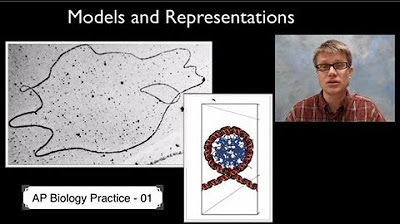2.10/2.11 - Compartmentalization/Origins of Compartmentalization - AP Biology
Summary
TLDRIn this AP Biology lesson, Mr. Poser explains the concept of cell compartmentalization, comparing prokaryotic and eukaryotic cells. He highlights the differences, with eukaryotes having membrane-bound organelles, allowing for more organization and surface area for reactions. The video also covers the endosymbiont theory, explaining how eukaryotic cells evolved from engulfing prokaryotic cells, like mitochondria and chloroplasts, which became integrated into eukaryotes over time. Mr. Poser emphasizes that this theory is well-supported by evidence, such as the presence of two membranes, ribosomes, and circular DNA in these organelles, indicating their bacterial origins.
Takeaways
- 😀 Prokaryotic cells lack membrane-bound organelles, and their contents float freely within the cell. In contrast, eukaryotic cells have compartmentalized structures that allow for better organization and specialized functions.
- 😀 Eukaryotic cells are highly compartmentalized, with distinct membrane-bound organelles such as mitochondria, chloroplasts, and the nucleus, which help separate various cellular processes and reactions.
- 😀 Compartmentalization in eukaryotic cells increases surface area for enzymatic reactions, improving cellular efficiency by preventing reactions from interfering with each other.
- 😀 Prokaryotes, like bacteria and archaea, are simpler in structure, with no membrane-bound organelles. However, they do have specialized structures like a protein capsule, cell wall, ribosomes, and nucleoid regions.
- 😀 The key benefit of eukaryotic compartmentalization is that it allows for more efficient and organized cellular processes. More membranes provide increased surface area for reactions and allow different enzymatic processes to occur without interference.
- 😀 The Endosymbiont Theory explains how eukaryotic cells evolved from prokaryotic ancestors. This theory proposes that an early eukaryotic cell engulfed an oxygen-using, non-photosynthetic prokaryotic cell, which evolved into mitochondria.
- 😀 Endosymbiosis occurs when one organism lives within another. The engulfed prokaryote became an integrated part of the host, providing energy for the cell through aerobic respiration, which benefited both organisms.
- 😀 A similar process is believed to have occurred with the evolution of chloroplasts, where an early eukaryotic cell engulfed a photosynthetic cyanobacterium, which evolved into the chloroplast.
- 😀 Evidence for the Endosymbiont Theory includes the fact that mitochondria and chloroplasts have two membranes (likely derived from the original prokaryote’s membrane and the engulfing vesicle), their own ribosomes, and circular DNA molecules similar to bacteria.
- 😀 Mitochondria and chloroplasts are autonomous, capable of reproducing independently, which further supports the theory that they were once free-living prokaryotic organisms.
- 😀 The evolution of eukaryotic cells through endosymbiosis provided significant advantages, such as increased surface area for reactions and the compartmentalization of various enzymatic processes, enhancing cellular efficiency and function.
Q & A
What is the main difference between prokaryotic and eukaryotic cells as described in the script?
-Prokaryotic cells lack membrane-bound organelles, meaning their components float freely in the cytoplasm. In contrast, eukaryotic cells have membrane-bound organelles like the nucleus, mitochondria, and chloroplasts, which compartmentalize different cellular functions.
Why is compartmentalization advantageous for eukaryotic cells?
-Compartmentalization in eukaryotic cells allows for different enzymatic reactions to take place in separate areas of the cell, preventing interference. This organization also increases surface area, providing more spaces for reactions and exchanges with the external environment.
How does the compartmentalization of eukaryotic cells compare to the organization of prokaryotic cells?
-Eukaryotic cells are highly organized, with membrane-bound organelles keeping different cellular functions separated. In contrast, prokaryotic cells have a less organized structure, with their components dispersed in the cytoplasm without membrane separation.
What does the term 'endosymbiosis' refer to in the context of eukaryotic cell evolution?
-Endosymbiosis refers to the theory that eukaryotic cells evolved through the engulfment of prokaryotic cells, with one prokaryote living inside another. This theory explains how mitochondria and chloroplasts evolved from independent prokaryotes.
What is the role of phagocytosis in the endosymbiont theory?
-Phagocytosis is the process through which an early eukaryotic cell engulfed another prokaryotic cell. This engulfed cell, which could perform processes like aerobic respiration or photosynthesis, eventually became the mitochondrion or chloroplast in eukaryotic cells.
How does endosymbiosis explain the presence of two membranes in mitochondria and chloroplasts?
-The two membranes of mitochondria and chloroplasts are explained by endosymbiosis. The outer membrane likely formed when the prokaryotic cell was engulfed by the eukaryote, while the inner membrane is the original membrane of the engulfed prokaryote.
What are some key characteristics of mitochondria and chloroplasts that suggest they originated from prokaryotes?
-Mitochondria and chloroplasts have two membranes, their own ribosomes, and circular DNA, which are characteristics typically found in prokaryotes. These features suggest that these organelles evolved from free-living prokaryotes.
Why is the circular shape of DNA in mitochondria and chloroplasts significant?
-The circular shape of DNA in mitochondria and chloroplasts is significant because it resembles the DNA found in prokaryotes. This supports the idea that these organelles were once independent prokaryotic cells before becoming engulfed by a larger eukaryotic cell.
What is the difference between a scientific 'theory' and a 'guess' as explained in the script?
-A scientific 'theory' is a well-substantiated, evidence-based explanation for a natural phenomenon, not just a guess. The endosymbiont theory is an example of such a theory, explaining how eukaryotic cells evolved from prokaryotes.
What evidence supports the endosymbiont theory, particularly for mitochondria and chloroplasts?
-Evidence for the endosymbiont theory includes the two membranes of mitochondria and chloroplasts, their own ribosomes, circular DNA, and the fact that they can reproduce independently. These characteristics suggest that mitochondria and chloroplasts were once separate organisms that were engulfed by a larger cell.
Outlines

هذا القسم متوفر فقط للمشتركين. يرجى الترقية للوصول إلى هذه الميزة.
قم بالترقية الآنMindmap

هذا القسم متوفر فقط للمشتركين. يرجى الترقية للوصول إلى هذه الميزة.
قم بالترقية الآنKeywords

هذا القسم متوفر فقط للمشتركين. يرجى الترقية للوصول إلى هذه الميزة.
قم بالترقية الآنHighlights

هذا القسم متوفر فقط للمشتركين. يرجى الترقية للوصول إلى هذه الميزة.
قم بالترقية الآنTranscripts

هذا القسم متوفر فقط للمشتركين. يرجى الترقية للوصول إلى هذه الميزة.
قم بالترقية الآنتصفح المزيد من مقاطع الفيديو ذات الصلة
5.0 / 5 (0 votes)






